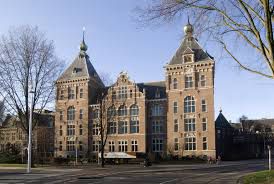

In the middle of 19th century, Frederick van Eeden, secretary of the Society for the Promotion of Industry established the Koloniaal Museum in Haarlem and, thereafter, opened it to the public in 1871. The museum was founded with the intention of promoting and presenting the Dutch overseas possessions, the inhabitants of these faraway lands and various paraphernalia that came from there. The institute began to research the means of increasing profits made from the trade with the colonies. This included attempts to develop improved ways of producing coffee beans, Rotan and paraffin. Ethnologists became interested in the museum and added the information they possessed on the economy, traditions and customs of the colonial inhabitants. In 1926, the imposing building in Amsterdam was inaugurated. At the time, the collection included 30,000 objects as well as a sizable collection of photographs.
In 1945, following Indonesias independence, the scope of the museum broadened from the former colonial possessions to that of many other underdeveloped ex-colonial countries in South America, Africa, and Asia. In the 1960s and 1970s the Dutch Ministry of Foreign Affairs encouraged the museum to expand its scope further to such social issues as poverty and hunger. In the early 1970s, a new wing for the children, now called Tropenmuseum Junior, was added.
The imposing building was built in 1926 and was designed by Van Nieukerken brothers. It was, and still remains, one of the most richly decorated buildings in the city, and it took 11 years to build it, due in part to the erupted World War I as well as various labor strikes. All of the artwork decorating the interior of the building was created in the first half of the 20th century. In 2003 it was listed as a monument.
The museum collection contains several hundred thousand objects, photographs and miscellaneous drawings, paintings, and documents from Southeast Asia, Oceania, Western Asia and North Africa, Africa, Latin America. It inherited 15,000 of these from the Ethnographisch Museum Artis (The Ethnographic Museum of the Artis Zoo). These objects are split up into many collections. Of particular interest is the theater collection which contains about 5,500 musical instruments as well as various other theatrical props, such as for example masks and puppets. It also features 21,000 textile artifacts, the majority of which are from Indonesia.
The financial crisis has not left Amsterdam cultural life unscathed and, in 2013, the museum announced that because of the budget cuts (the donations from the Ministry of Foreign Affairs were canceled in their entirety), the library will close and sell off its collection which included some 900,000 books, maps, and other items.
The museum is home to the KIT or the Royal Tropical Institute. The Colonial Institute and the Colonial Museum merged in 1910 to form the KIT, an organization whose purpose it is to increase public awareness of other cultures and increase communication between them. Together with the KIT, Tropenmusem works with foreign museums and supports their collections. For example, with the support provided by the Tropenmuseum and the KIT, the Museum Bus was launched in the West African state of Benin: this project led to the creation of a museum inside a bus that could reach people in remote rural areas. Building on earlier work by the Getty Information Institute, the museum has also started projects in fourteen developing countries aimed at cataloguing and creating databases of foreign museum collections using a computer program. This contributes significantly in countering theft and illegal trade in developing world art treasures.